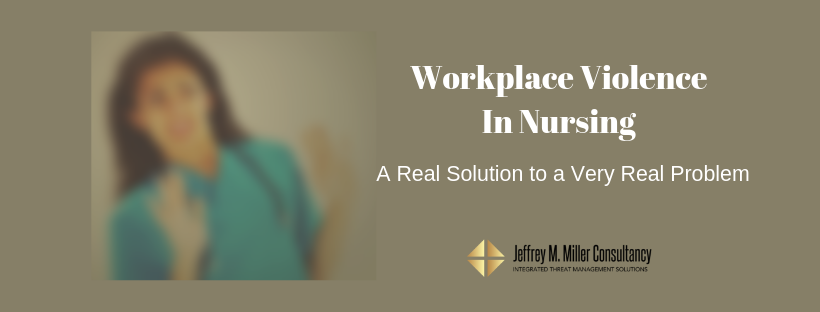
This post was inspired by the recent news story of the Dignity Health nurses picketing for a safer work environment, as well as other stories related to workplace violence against nurses. You can read more about the Dignity Health workplace safety complain here. The article itself has also been cross-posted via Pulse on Linkedin.
Workplace Violence In Nursing
A Real Solution to a Very Real Problem
by Jeffrey M. Miller SPS, DTI
There is no doubt in anyone’s mind that workplace violence continues to be on the rise, as-well-as a clear and present danger for every business. The Department of Justice and O.S.H.A. report that no business is immune to it. Surprising to many though, is the fact that one of the industries affected most by workplace violence attacks is that of healthcare – specifically nursing.
And, while there continue to be incidents where nurses picket and protest against their organization to get better safety measures, as-well-as those who fight for new legislation that will put laws in place to either impose greater punishment on those who act out, or mandates on healthcare organizations to provide safer working conditions; the reality is that neither of these things will stop the damage from occurring when an actually assailant attacks. One of the reasons for this is that people are trying to apply logic and reasoning to deter an otherwise irrational individual, or one who is acting with criminal intent… neither of which care about your logic and reasoning!
Unlike a typical workplace violence “Zero Tolerance” policy in, say, a manufacturing business where things can be made more secure and hiring practices can be used to weed out potentially aggressive employees, a healthcare facility is a “soft target” that is open to the public and therefore less easy to control with conventional prevention tactics. This, coupled with the fact that the typical assailant attacking a nurse is doing so out of a sense of fear, grief, pain, medications, or an un-diagnosed psychosis, makes healthcare not only different from the majority of industries, but also the reason the FBI created a sub-category for them.
Statistics presented at events like the annual “International Conference on Violence in the Health Sector” and “Congress on Violence in Clinical Psychiatry” clearly show that, regardless of the evidence highlighting the need for greater training and safety protocols, and the effectiveness of such things, nurses are not being given what they need to actually BE safer on the job. Organizations are still leaning toward one-off training programs that are not easily remembered, and security-based initiatives that ignore the problems with lags in response time, and others issues that just cannot make-up for the need for nurses receiving the training that will make them an active, integral part of their own safe working environment.
Security and workplace violence training for nurses and other medical staff should be seen as an investment with a positive ROI, rather than as another non-profit-centered expense. Because, when the right systems, protocols, procedures, and training are in place, patients and staff alike feel safer and less stressed. This equates to not only better job performance on the part of staff, with less lost-time incidents and reduced employee turn-over, but also a better reputation for the facility and organization and a greater willingness on the part of potential patients WILLINGLY choosing that hospital over another option,
Looking at the problem through the lens of strategic perspective, and not merely the limited viewpoint of ‘throwing more guards’ at a problem as a simple, gut-level response, it’s easy to see how the requisite training that allows nurses to effectively respond to acts of violence is, and has long been, sorely missing. And, if healthcare organizations want to stop the bleeding from their bottom lines from such real, debilitating expenses as: lost-time cost, employee turnover and the related recruitment, training, overtime, etc. that results; lower productivity and job satisfaction; higher stress and stress-related illnesses; and potential O.S.H.A. complaints or law suits for injuries sustained; they are going to have to address the reality that, unfortunately, sometimes violence IS a part of the job and, just as is done in law enforcement, get the right kind of long-term, liability-conscious training in place – training that is customized to nursing, and proven to work against a variety of attacker types and their methodologies.
With nurses being 25 times more likely to be attacked on the job than a police officer, and accounting for upwards of 75% of the daily assaults that occur in the workplace – assaults which can happen faster than any guard can respond to, even one in the same room – it’s unconscionable how this type of oversight continues. We must remember that security guards are, first and foremost, a deterrence… not an end-all to beat-all answer, especially in those situations where the assailant knows that security is present but chooses to act anyway.
Designing effective safety protocols, as-well-as customized response training and not merely relying on “zero-tolerance” statements or non-aggression agreements, are both THE most overlooked factors, AND two of the most significant things an organization can do to protect it’s people, it’s assets, it’s reputation in the face of negative PR, and it’s bottom line from the effects of workplace violence.
Are you concerned that your staff is safe enough? Want to take the next step to protecting them from the next attack? If so…
Download the Workplace Violence Program Assessment Self-Audit Tool now. This short, easy-to-complete management tool is is an abridged version of the one we use and designed to give you a clearer picture of where you are and where to begin with making your staff more safe and secure. Click here to get your complimentary Workplace Violence Program Assessment Tool now.
ABOUT THE AUTHOR
Jeffrey M. Miller is the Founder and Principle Consultant of the Jeffrey M. Miller Consultancy, an independent consulting firm created to help CEOs and senior HR, Operations, Nursing & Security leaders identify potential threats and design customized policies, procedures and related training that gives them the peace-of-mind from knowing that their people are as safe as possible from the horrors, fear, damage and loss of workplace violence.
He is the author / co-author of several books, videos, and training programs, including: “Workplace Violence in Mental and General Healthcare Settings” (2011, Michael Privitera, ed.), “GIS in Hospital and Healthcare Emergency Management” (2010, Ric Skinner, ed), “Danger Prevention Tactics: Protecting Yourself Like a Pro!,” and the “Rapid Reset & Recharge” 3-Minute Stress Reduction Meditation System for Busy Professionals. Among others, Jeff has helped such organizations as Geisinger Health System, AAIM, Nissan North America, and the Stephen F. Austin University School of Nursing.
He can be reached via his office at: (570) 884-1119 or [email protected].

